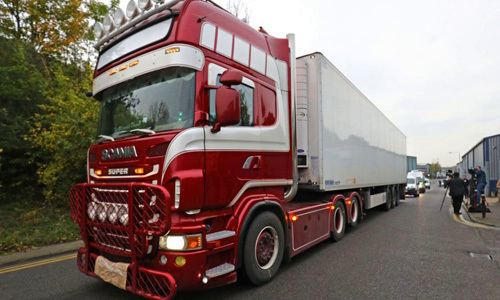In 2018, about 3.6 million trucks and containers entered the UK through 40 major ports, but most were not inspected.
The British Interior Ministry said the Border Guard inspects vehicles "on certain grounds", but did not specify the number of vehicles inspected each year as well as the criteria for determining the target. According to a spokesman, the Border Guard has experience in identifying containers that need to be searched at a port.

A container truck carried 39 bodies in Essex County, east London, England on October 23 Photo: Reuters
Some measures to detect illegal migrants hiding in trucks include the use of a CO2 concentration meter, motion detection sensors and sniffing dogs.
Lucy Moreton, representative of the Migration Service Federation, said the number of containers entering the UK every day was so high that they could not check inside all cars. "We do not have the conditions to check most of the goods entering the UK," she explained. "Hundreds of thousands of individual containers arriving in the UK every day are less likely to be searched, unless there is a warning."
Each container will have an order filled by the orderer. However, the carrier can fill out the application on behalf of the customer. If conditions allow, drivers will usually check to see if they are the same as the order information.
However, Heather Wallace, representative of the Association of Road Freight, said drivers "are often not present when the goods are loaded into the car and trust the customer."
Containers can be moved by tractor, or left at the port for employees to board the ferry and hand over to the second driver. "This process depends on the cost, flexibility and urgency of the goods," Wallace said.
Mo Robinson, a 25-year-old driver from Northern Ireland, was the driver of a container truck carrying 39 bodies discovered in Essex, east London on October 23. He drove his red-and-white tractor from Dublin, Ireland to the town of Holyhead in Wales by sea on October 19, then continued on to Essex County and waited until 23 October to reach Purfleet Harbor. receiving containers. It is unclear why the driver arrived in Essex 4 days before the shipping schedule.
The Belgian Federal Prosecutor's Office said the container arrived at the country's Zeebrugge port on the afternoon of October 22, and was then taken to the Port of Purfleet, which handles about 250,000 containers a year. Officials have yet to answer the question of where the container was before arriving at Zeebrugge and how it was delivered there.
Container truck route carrying 39 people to the UK (Click on image for details). Graphics: Tien Thanh.
About 4,000 trucks arrive and depart the UK through the Port of Zeebrugge every day, while there are concerns about security there. Belgian Minister for Migration According to Francken last year, 600 security cameras at the port were not enough to guarantee them. The British government has repeatedly warned that the risk of human trafficking from Belgium has been increasing over the past three years and that Zeebrugge is a key point on the journey.
30 minutes after attaching the refrigerated container trailer to his truck for transportation, Robinson parked his car in the Waterglade industrial park, 32 km from central London, and opened the container. The driver phoned the local ambulance agency when he discovered that many people inside and the medical staff had informed the police. Some argue that Robinson is most likely unaware that there are 39 people in the container.
Intentional human trafficking is a criminal offense with a sentence of up to 14 years imprisonment and a fine of £ 10,000 (over 12,800 USD). However, drivers who unknowingly carry people crossing the border are still likely to face civil sentences.
Under the UK Migration and Refugees Act of 1999, a truck owner, car renter or driver may be prosecuted if the vehicle is accompanied by a "person secretly on entry". The fine is £ 2,000 (about US $ 2,500) for each illegal immigrant.
They may defend by proving they do not know or "have no reasonable grounds to doubt" about the presence of anyone in the vehicle, or have taken appropriate inspection to prevent others. Get in the car and cooperate with the authorities when it detects an incident.
The Border Guard also asked drivers to comply with the 10-point plan that included instructions such as monitoring the loading process, careful door locking, checking locks, windshields and axles after each. stops and port entry and exit points.



 JoJenssen
JoJenssen







